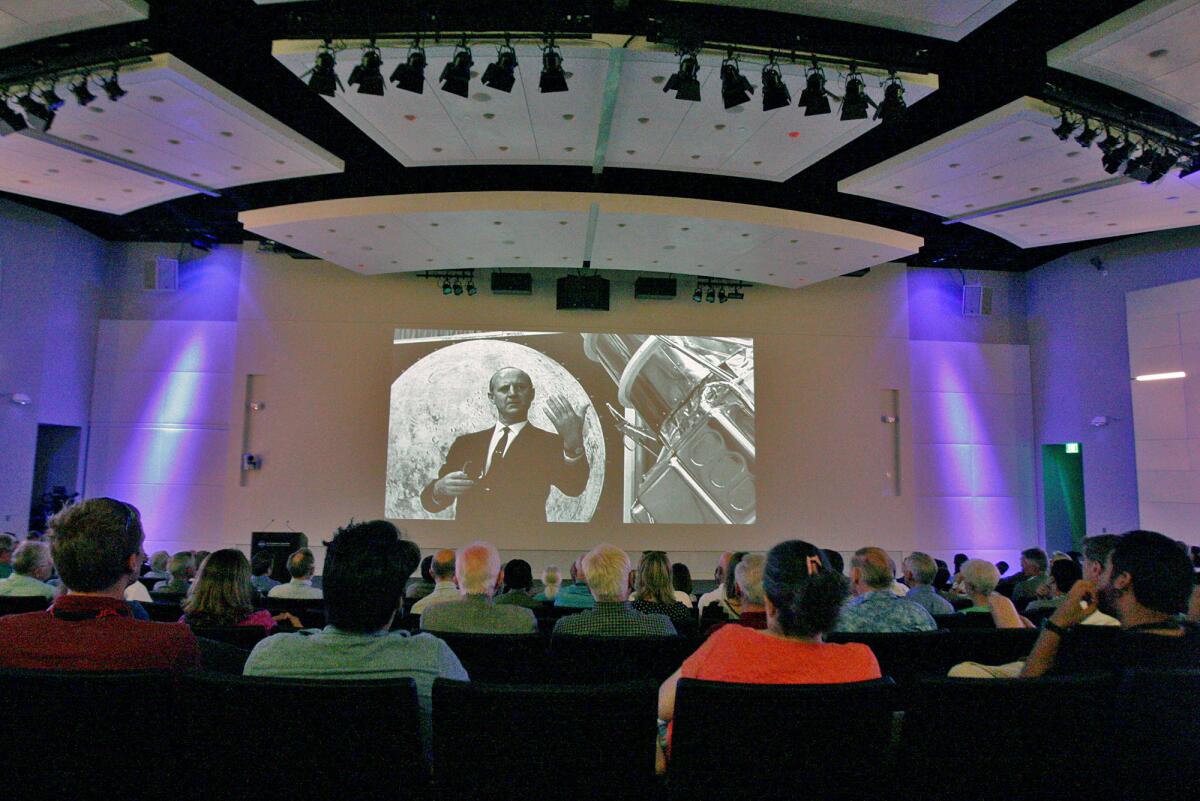NASA’s JPL honors its former director

Attendees view a video of the late William Pickering at the dedication of the Pickering Auditorium at NASA’s Jet Propulsion Laboratory on Monday, July 27, 2015. Pickering was the director of JPL for 22 years, from 1954 to 1976, and is credited with the motivation and execution of deep space exploration.
- Share via
As the director of NASA’s Jet Propulsion Laboratory for 22 years, William Pickering oversaw the lab’s space exploration in the 1950s, ’60s and ’70s, and his missions’ successes paved the way for modern victories.
On Monday, his legacy in guiding robotic exploration to the moon and planets was honored once more with the unveiling of his name on what was formerly known to JPL employees as the 321 Auditorium.
A New Zealand native, Pickering began working at JPL in 1944, when the lab was producing missiles for the U.S. Army.
By 1954, he was directing the lab, and in 1958, NASA took over, and suddenly Pickering openly shared stories and jokes about his day at the office with his family, according to his daughter, Beth Pickering Mezitt, who said he had always remained tight-lipped about his prior classified work on rockets for the U.S. Army.
She said her family soon experienced his passion overflow for JPL’s new mission to explore space.
Among the lab’s first major successes was the 1958 launch of Explorer 1, the first U.S. satellite.
“My dad’s excitement was huge,” his daughter said on Monday of his initial orders by NASA to explore space. “He now had the opportunity to combine his love of planets and stars with the engineering and physics that he so loved.”
As the lab prepared to embark on new territory, it came with high pressure from the U.S. government and President John F. Kennedy’s challenge to put a man on the moon by the end of the 1960s.
“Particularly, at that time, we barely knew how to launch things,” said JPL Director Charles Elachi, during the auditorium’s dedication. “There was tremendous pressure on the lab during that period, you know, the Cold War.”
Elachi said there were ups and downs — and several consecutive failures — in the lab’s effort to land robots on the moon to secure more knowledge about its properties.
Still, there were major successes, including the Mariner missions that Pickering oversaw in attempts to visit the planets.
The first visit occurred in 1962 when the Mariner 2 spacecraft successfully conducted a flyby of Venus after a 180-million-mile journey.
A few years later, in 1965, Mariner 4 snapped the first close-up photos of Mars, revealing its rust-colored surface, according to NASA.
“They focused on the challenge, and [here’s] where we are today,” Elachi said. “He really led us today to visit every planet in the solar system.”
Pickering retired as director of the lab in 1976, but remained active until his death at age 93 in 2004.
“He also never entirely left JPL,” recalled his daughter, Beth. “He had his telescope in his dining room, where he could look down on JPL and see what was going on.”
Pickering lived on St. Katherine Drive in La Cañada, on the hills south of JPL.
Larry James, deputy director of JPL, said that placing an individual’s name on a federal building is a highly rare and special event. But the request to place Pickering’s name on the auditorium was embraced by officials at NASA headquarters.
“There was never any question. There was never any pushback. It was basically, ‘Yes, this is the right thing to do,’” he said.
In her thanks to JPL for the newly named Pickering Auditorium, Beth Pickering Mezitt said, “You’re honoring him in a most wonderful way. This is where his heart is and you have honored that.”